
What Is a Military Drone?
A military drone is technically referred to as an Unmanned Aerial Vehicle (UAV). It is an aircraft with no human pilot on board. These drones may be controlled remotely by operators on the ground or fly autonomously using onboard computers and sensors with pre-programmed flight paths.
Most military drones are deployed for missions such as reconnaissance, target tracking, and in many cases, direct attack operations.
What Makes Military Drones So Necessary?
Drones have altered the game of warfare. For instance, armies can now collect information, track enemy movements, and precisely bombard a particular target-all without putting the life of a pilot at risk. Generally speaking, they are very cheap in cost, highly versatile, and can operate in dangerous or denied environments, making them a very attractive addition to most armed forces independent of their strength, size, or composition.
These features makes them an attractive tool not only for major military powers but also for smaller nations seeking advanced capabilities without the need for expensive infrastructure or manned platforms.
Categories of Military UAVs
- Reconnaissance Drones: Used for intelligence gathering and surveillance. Example: RQ-4 Global Hawk.
- Combat Drones (UCAVs): Armed with bombs or missiles. Examples: MQ-9 Reaper, Bayraktar TB2.
- Loitering Munitions: Known as “kamikaze drones”; they hover over a target area and strike at the right moment. Example: Shahed-136.
- Micro/Nano Drones: Small, often hand-launched drones used in urban warfare or special operations.
What a UAV System Consists Of
A military drone system is much more than just a flying machine. A complete UAV system typically includes:
- The drone itself (airframe and payload)
- Ground Control Station (GCS)
- Data link systems for communication and real-time control
- Support equipment such as launchers, recovery systems, and maintenance gear
Examples of Modern Military Drones
- MQ-9 Reaper (USA): A long-endurance, high-altitude UCAV used for precision strike missions.
- Bayraktar TB2 (Turkey): A highly popular combat drone known for its success in various conflict zones.
- Wing Loong II (China): A multirole armed UAV widely exported to Asia and Africa.
- Heron TP (Israel): A long-range, high-altitude surveillance drone with extended operational reach.
Who Produces What? A Country-by-Country Look
| Country | Key Drones Produced | Notable Manufacturer |
|---|---|---|
| United States | MQ-9 Reaper, RQ-4 Global Hawk | General Atomics, Northrop Grumman |
| Türkiye | Bayraktar TB2, Akıncı, Anka | Baykar, TUSAŞ |
| China | Wing Loong II, CH-5 | AVIC, CASC |
| Israel | Heron TP, Harop | IAI, Elbit Systems |
| Iran | Shahed-136, Mohajer-6 | Qods Aviation |
| Russia | Orion, Lancet-3 | Kronshtadt, ZALA Aero Group |
| United Kingdom | Watchkeeper WK450 | Thales UK, Elbit Systems UK |
| France | Patroller UAV | Safran |
Changing How Wars Are Fought in the Real World
Drones moved from testing grounds to battlefields. For instance, they made a big impact during the 2020 Nagorno-Karabakh conflict, when Azerbaijani forces employed the Turkish-made Bayraktar TB2s and Harops made by IAI to neutralize enemy flanks. Whether from surveillance or precision bombing, both sides in Ukraine have also turned to relying on UAVs and loitering munitions. Now, more than ever, drones redefine the cadence, tactics, and geography of wars-better than any traditional system before.
Conclusion
Military drones are no longer something of the future; they are at the center of modern military operations. UAVs have shifted the military from silent observation to precision strikes, thereby enabling a military to act faster, smarter, and more efficiently. Indeed, with time, their roles will only increase and transform the warfare and decision-making processes.
In the next lesson, we take a closer look at the armored giants of the battlefield. What exactly makes a tank a “Main Battle Tank”? Let’s find out.






